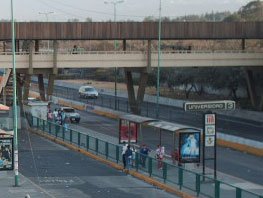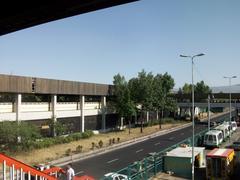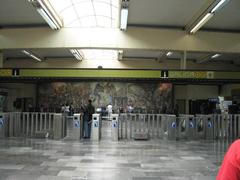
Universidad Mexico City (Ciudad Universitaria) Visitor Guide: Hours, Tickets, and Must-See Attractions
Date: 14/06/2025
Introduction
Ciudad Universitaria (C.U.), the main campus of the National Autonomous University of Mexico (UNAM), stands as a beacon of Mexico’s educational ambition and cultural heritage. Located in the southern borough of Coyoacán, this sprawling 20th-century modernist complex is not only an elite academic hub but also a UNESCO World Heritage Site recognized for its innovative urban planning, integration of fine arts, and deep social significance (UNESCO; World Heritage Site). Whether you are passionate about architecture, art, history, or simply exploring Mexico City’s unique landscapes, Ciudad Universitaria offers a richly rewarding experience.
Table of Contents
- Historical Overview and Cultural Significance
- Key Architectural and Artistic Highlights
- Museums and Cultural Centers
- Visitor Information: Hours, Tickets, and Tours
- Getting There and Campus Navigation
- Practical Tips for Visitors
- FAQ
- Visuals and Media Resources
- Summary and Visitor Recommendations
- Sources
Historical Overview and Cultural Significance
Origins and Development
Built between 1949 and 1952 atop the ancient volcanic lava fields known as the “pedregal,” Ciudad Universitaria was born out of Mexico’s post-revolutionary vision for modernization. Over sixty architects, engineers, and artists—including Mario Pani and Enrique del Moral—collaborated on what would become the largest single construction project since the Aztec era (The Creative Adventurer). The site’s volcanic foundation not only directed the campus layout but also inspired the use of native rock in its construction, blending modernism with indigenous motifs.
UNESCO World Heritage Status and Social Impact
Awarded UNESCO status in 2007, Ciudad Universitaria is celebrated for its innovative urban planning and its role as a symbol of Latin American modernity. It has been a crucible for social change—most notably the 1968 student protests—and continues as a vibrant center for festivals, exhibitions, and public discourse (UNESCO).
Key Architectural and Artistic Highlights
Central Library (Biblioteca Central)
The Central Library is perhaps the most recognized structure on campus, distinguished by Juan O’Gorman’s monumental mosaic murals. Each side of the building depicts a different era in Mexican history—pre-Hispanic, colonial, modern, and contemporary—crafted entirely from colored stones sourced across the country (Amusing Planet). The simple, functionalist design serves as a canvas for this national narrative.
Olympic Stadium (Estadio Olímpico Universitario)
Completed in 1952, the Olympic Stadium is Mexico’s second largest and was the main venue for the 1968 Olympics. Architect Augusto Pérez Palacios designed the stadium to integrate with the volcanic landscape, with Diego Rivera’s mural “La Universidad, la Familia y el Deporte en México” adorning its exterior (Touropia).
Rectory Tower (Torre de Rectoría)
Home to the university’s administration, Rectory Tower features murals by David Alfaro Siqueiros, highlighting the symbiotic relationship between university and society. The east facade showcases stylized national symbols—golden eagle, great condor, and a radiant sun (The Creative Adventurer).
Sculpture Space (Espacio Escultórico)
This open-air park on the campus outskirts features monumental sculptures by prominent Mexican artists, arranged around a natural lava formation. It offers panoramic views and a contemplative environment for engaging with contemporary art (Condé Nast Traveler).
Botanical Garden (Jardín Botánico)
Showcasing over 800 species of cacti—the world’s most diverse collection—the Botanical Garden is both a conservation center and a tranquil retreat, highlighting Mexico’s rich botanical heritage (Nomadic Matt).
Museums and Cultural Centers
- Museo Universitario Arte Contemporáneo (MUAC): A premier venue for post-1960s contemporary art, renowned for its modern architecture and experimental sound installations (Time Out).
- Universum Science Museum: An interactive museum with exhibits on physics, biology, and environmental science—ideal for families and children (Mexico Travel Blog).
- Sala Nezahualcóyotl: Home to the UNAM Philharmonic Orchestra, this concert hall is considered one of Latin America’s best.
- Centro Cultural Universitario: A hub for theater, film, and exhibitions.
Visitor Information: Hours, Tickets, and Tours
General Campus Hours
- Campus Grounds: Open daily, 8:00 AM – 6:00 PM. Some outdoor areas may open as early as 7:00 AM.
- Museums and Venues: Hours vary. MUAC is open Tuesday–Sunday, 11:00 AM–6:00 PM; Universum operates Tuesday–Sunday, 9:00 AM–5:00 PM. Always check specific venues’ official sites for updates.
Tickets and Entry
- Campus Entry: Free.
- Museums: Modest fees (typically 40–70 MXN), with discounts for students and seniors.
- Guided Tours: Offered by UNAM’s cultural departments and external providers. Booking ahead is advised, especially for the Olympic Stadium and specialized mural tours.
Special Notes
- COVID-19 Protocols: Health measures may affect opening hours and capacity. Check for updates before your visit.
- Accessibility: Most major buildings and transport options are wheelchair accessible, though some outdoor areas retain uneven volcanic surfaces.
Getting There and Campus Navigation
- Metro: Line 3 to “Universidad” station. From there, pedestrian walkways and free Pumabús (internal buses) connect to key campus sites (Mexico City Metro Guide).
- Metrobus: Line 1 stops at “Ciudad Universitaria.”
- Internal Transport: Pumabús offers multiple routes; maps are available at entrances.
- By Bicycle: Rental stations are available at campus gates.
- Parking: Limited; public transit is highly recommended.
Practical Tips for Visitors
- Orientation: The campus is vast. Pick up a map at visitor centers or download one from the official website.
- Language: Spanish is predominant, but some signage and tours are available in English.
- Food and Restrooms: Cafeterias and food stalls are scattered across campus, especially near the Philosophy and Literature department. Public restrooms are accessible in major buildings.
- Safety: Ciudad Universitaria is safe by day, but use standard urban precautions. Avoid isolated areas after dark.
- Weather: Mild year-round; bring a light jacket for evenings or rainy season visits (Let’s Travel to Mexico).
- Wi-Fi: Free Wi-Fi is available in main areas (“UNAM” or “eduroam” networks).
Frequently Asked Questions (FAQ)
Q: What are the general visiting hours for Ciudad Universitaria?
A: Most outdoor areas are open 8:00 AM to 6:00 PM daily. Museum and venue hours vary—always check official sources.
Q: Is there an entrance fee for the campus?
A: Entry to the campus and most outdoor spaces is free; museums and special exhibitions may charge a fee.
Q: How do I book a guided tour or stadium visit?
A: Guided tours can be arranged through UNAM’s cultural offices or authorized tour operators. Stadium tours require advance booking via email.
Q: Is the campus accessible for people with disabilities?
A: Most key areas and internal transport are wheelchair accessible, but some paths have uneven volcanic surfaces.
Q: How do I get to Ciudad Universitaria using public transportation?
A: Take Metro Line 3 to “Universidad” or Metrobus Line 1 to “Ciudad Universitaria.”
Q: Are guided tours available in English?
A: Yes, several operators offer English-language tours; book in advance.
Visuals and Media Resources
- Interactive Maps: Available through the official UNAM website.
- Virtual Tours: Explore murals and buildings online for a preview of what to expect.
- Images: Look for alt text such as “Juan O’Gorman mural at Central Library” or “Ciudad Universitaria Olympic Stadium.”
Summary and Visitor Recommendations
Ciudad Universitaria is a living monument to Mexico’s pursuit of educational excellence, artistic innovation, and social progress. Its architecture and murals, ecological reserves, and cultural venues offer an immersive experience at the intersection of history and modernity. For a full experience:
- Use public transportation for easy access.
- Take a guided tour for deeper insights into the art and architecture.
- Visit museums, green spaces, and cultural centers to enjoy the campus’s diversity.
- Download the Audiala app for audio guides and updated visitor information.
Sources
- Ciudad Universitaria Mexico City: Visiting Hours, Tickets, and Historical Insights, 2025, UNAM Official Guide (https://www.unam.mx/)
- Visiting Ciudad Universitaria: Hours, Tickets, and Guide to Mexico City’s Iconic Modernist Campus, 2025, The Creative Adventurer (https://thecreativeadventurer.com/the-ultimate-guide-to-the-architectural-wonders-of-unam-campus-in-mexico-city/)
- Visiting Central University City Campus (UNAM): Hours, Tickets, and Must-See Mexico City Historical Sites, 2025, World Heritage Site (https://www.worldheritagesite.org/list/Central+University+City+Campus+of+the+UNAM)
- Ciudad Universitaria (UNAM) Visitor Guide: Hours, Tickets, and Must-See Attractions in Mexico City, 2025, Time Out Mexico City (https://www.timeout.com/mexico-city/things-to-do/the-best-things-to-do-in-ciudad-universitaria-unam)
- The Murals of UNAM: A Living Canvas of Mexican Identity, 2016, Amusing Planet (https://www.amusingplanet.com/2016/03/the-murals-of-national-autonomous.html)
- Mexico City Tourism Board Official Website, 2025 (https://www.visitmexico.com/)












































































































































































